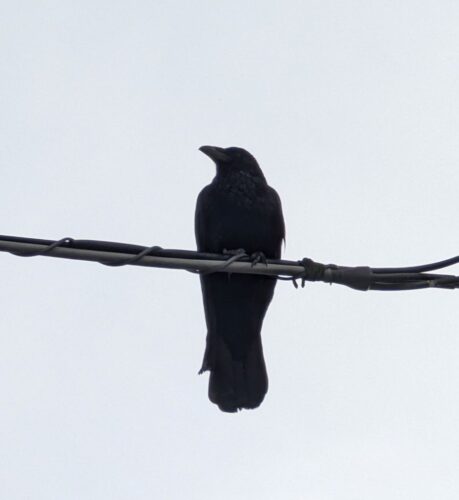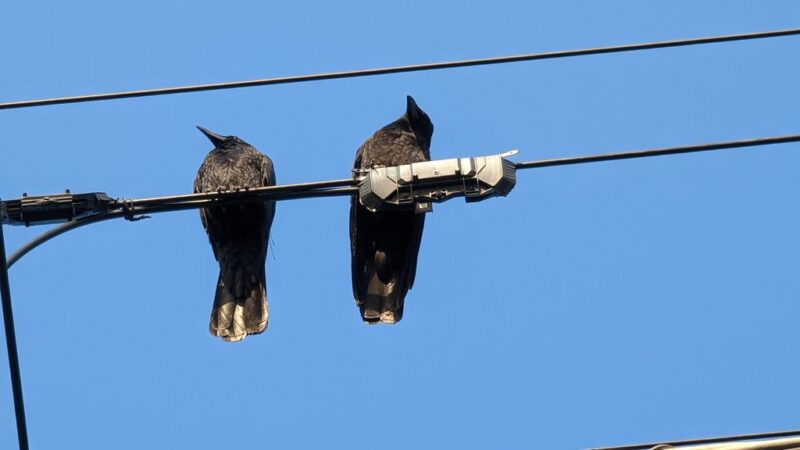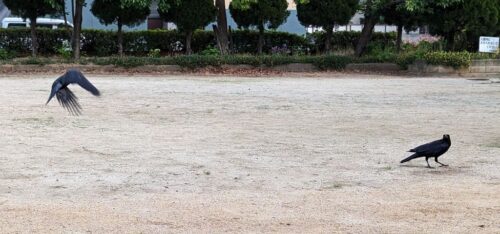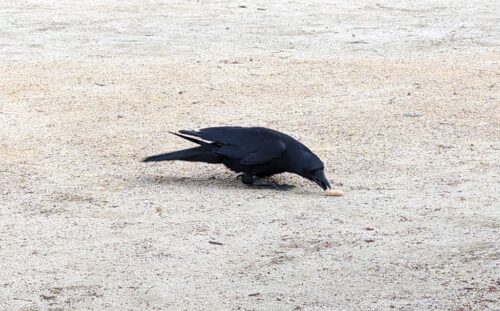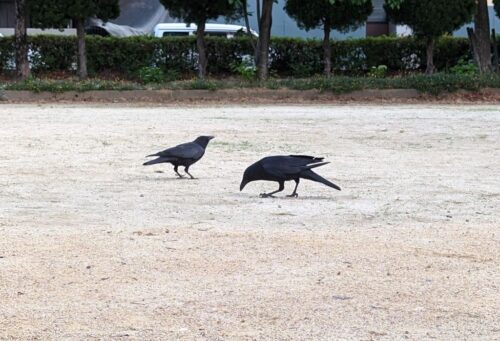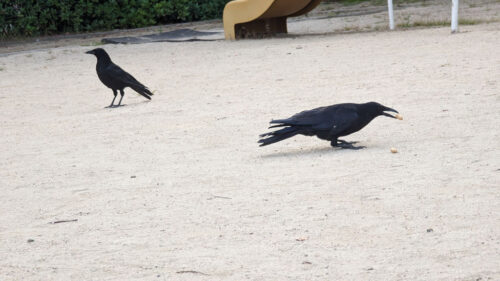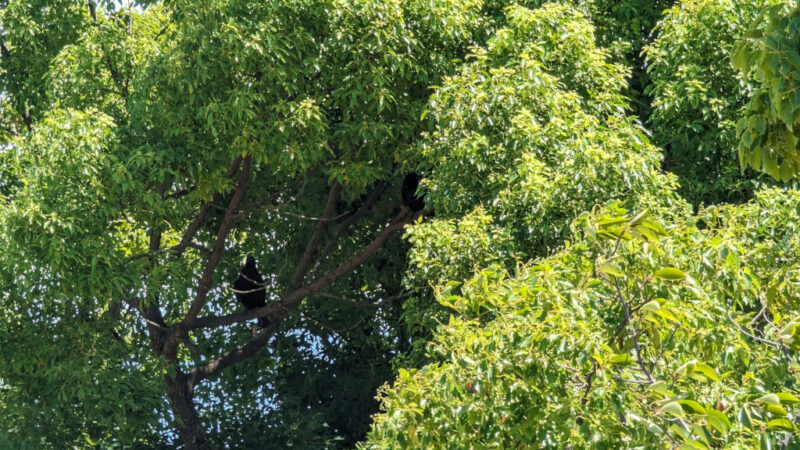Mr. and Ms. Crow have returned and…
Wait… I’m more than overdue for an update, four months are missing, and what four months!!!
Well, if you follow me on the fediverse (Mastodon and more) you already know a lot of what has been happening with the crows in the park next to my house. If you don’t follow me there… Well, first, may I advise that you do (I can even help you join, there is a small learning curve, but don’t let that stop you). But even if you don’t, don’t worry, I got you covered with this post.
Warning: It’ll be long and contain many pictures of crows.
Also, if you missed the beginning, don’t worry, you still can read the first two articles:
So, let’s get started, shall we?
In March, I returned to France for a few weeks. Once back home here in Japan, I was wondering how the crows would react to me being absent for so long. I got my answer on the first morning I was back, on April 2nd, as Mr. Crow saw me and waited for me and his treat at one of his usual spots.
I instantly noticed that something was off with his wings. However, to this day, I have no idea what happened. Most likely a fight. With other crows? I doubt it, I believe that all the other crows in the neighborhood are his family, possibly his kids. With some black kites? Maybe.
However, he was really happy to see me. He even came back later on the same day.
A few days later, on April 5th and 6th, I met with him in the park (note that I saw him pretty much every day, give or take a few, during the Spring, I just didn’t take pictures every day), the injury to his wing was very obvious:

On April 22nd, Ms. Crow came to eat some peanuts too.
She had been rare since my return, and it could only mean one thing: she was nesting! That also explains Mr. Crow being on the lookout most days.
People sometimes ask me how I can tell them apart. As you can see here, Mr. Crow’s tail and wings form an angle (he’s on the right side) while Ms. Crow doesn’t really have this angle (she’s on the left). I don’t think it’s some sexual dimorphism; apparently, male and female crows don’t really have any, except for their size (males are a bit bigger). I thought it came from his wing injury, but looking at the oldest pictures from last winter, he already had that angle, so maybe it comes from an older injury.
They’re not that young, they’ve been around since I moved to this house (oh, tomorrow will be my sixth year anniversary living in my house here, by the way).
Another way I can tell them apart is behavior. I have bonded with the male much more than the female who remains more shy.
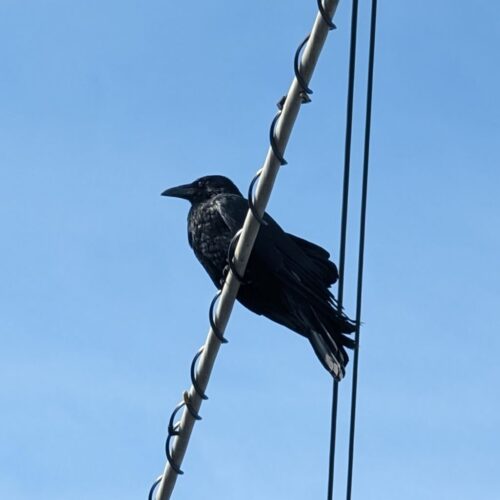
In late April, early May, it was obvious that some eggs were involved in the story. Ms. Crow was nowhere to be seen most days, while Mr. Crow had become an expert at guarding the park and making sure no potential danger comes close.
Actually, in the past, the park did not use to have many birds, because the neighborhood was plagued with stray cats. About a year ago, they all vanished (I assume someone “took care” of them, not sure if it’s the municipality or someone who took matters into their own hands), and since then, nature has been back. There are so many more insects and birds everywhere.
Remember, if you have cats, you shouldn’t let them outside. Wherever you live (except maybe around Syria), your environment is not a cat’s natural environment. They are an invasive species and they will wreak havoc on that environment. Nature doesn’t need this nowadays. Also, do you really want your cat to die young under the tires of a car? Because this is what is going to happen eventually.
But back to crows. Yes, since the stray cats are gone, birds have come back in large numbers in the neighborhood. Still, they did avoid the park in the Spring, except for the tiny ones such as the sparrows. On the one hand, they’re scared of the crows year-round, on the other hand, crows know that they’re harmless for them, so they mostly leave them alone. Pigeons and doves simply keep their distance (you can see them taking over the park as soon as the crows go somewhere, and leave as soon as the crows return). The real threats are the eagles (black kites, actually). They never really land around the houses, but they fight with the crows quite regularly.
Anyway, I decided that it was time to find the nest. I knew the location of their old nest, but they had abandoned it, and it was not really usable anymore. Also, I noticed, before going to France, that they were very busy in the tree right next to the one with the old nest. For a couple of days, I thought I had found it, but the lack of activity surrounding it made me doubt it.
Until, on May 3rd, I found a third nest! It was on the same tree, but very well hidden and… Well… Look…

You don’t see anything? How about if I zoom in a little?
A crow’s beak! Ms. Crow’s!
Also, notice how coat hangers are a regular part of a crow nest’s structure in Japan. That’s how they’re so sturdy and can sometimes be reused several years in a row.
Another shot from a different angle leaves no place to doubt:
You can see how Mr. Crow is not afraid to eat his peanut close to me, while Ms. Crow will grab it and eat it in the distance.
May 7th was a very rainy day, but Mr. Crow stayed on this utility cable most of the day!
This’s him in both pictures. That’s devotion.

Notice how his damaged feathers are almost completely gone. They’re supposed to be regrowing soon, but as I’m typing this (on July 30th), it hasn’t happened yet.
Now, I’m not sure about the timeline anymore, but two incidents happened, and I can’t remember which one was first and whether they’re related or not.
Thinking that it was soon time for the fledglings to leave their nest, I walked around the nest more and more to try to catch a glimpse of them. There is something strange with crows and ravens (and other corvids?) that you need to know.
Fledglings leave their nest before being able to really fly!!!
Yes, you read me right. I’m not sure why, but I’m gonna assume that it’s a bit similar to us humans. You may have noticed that humans are born “too early” compared to many other mammals. When most mammals are born, they can walk, see and do a few more things if not right from birth, at least very quickly after birth. For humans, it takes a much longer time to learn a lot of the basic skills that are required for simple survival. There are a lot of theories about the reason for this and it seems that the most likely one is that the most important skills humans need to learn are social and communication skills, as we probably are the most social animals and all. So we’re born “too early” in order to have more time to bond with our family, and other humans, and learn all the social skills and behaviors needed to be able to function as social beings. The fact that we can’t survive the first months (well, years, really) without caretakers is part of our socialization.
I suspect something similar with crows. Crows are some of the most intelligent animals on earth, and they’re also highly social, and leaving the nest “too early” is probably part of the same process.
Disclaimer: I base this on nothing but a hunch, basically. I’ll try to find out if some research has been done on the issue, in the meantime, don’t quote me on this.
So, back to the second week of May…
As I said, two incidents that may or may not be connected happened.
First, as I was looking around the nest to possibly find some fledglings… I found one… Dead… Right under the nest… 😨
I didn’t take a picture, that was too macabre. It had been dead for a couple of days, I assume.
Also, right after (or right before… maybe I should have taken a picture after all) one evening as I was returning from work, I heard some commotion with the crows on the other side of the park. I went to check it out and this is what happened:
The crows were more than angry with this cat who wasn’t too phased by them (I think that’s its house).
Once again, I don’t know what happened. I’m pretty certain that the cat didn’t climb the tree and grabbed the fledgling from the nest. The nest is just too high for a cat. Or if a cat was silly enough to climb that high, I’m pretty certain it wouldn’t be able to come down (you know how cats can be with climbing up and not climbing down).
My theory is that either the cat killed this fledgling who was already out of the nest (or another one?), or it has nothing to do with killing the fledgling, it just wanted to grab its corpse or something like that (but cats are not supposed to be scavengers, right?)
In any case, I never saw Mr. and Ms. Crow being angrier.
I guess I’ll never know.
Both Mr. and Ms. Crow spent the next few days on poles or cables, barely moving. I had heard of crow funerals and I was wondering if that was it (more on crow funerals later).
But… On May 16th…
Mr. Crow was on a utility pole by the park and I went out to give him some peanuts.
But he wouldn’t come down. He clearly wanted the peanuts, but he stayed on his pole. I looked around and… On a branch right next to me, almost at eye level, there he/she was:
Yes!!! A fledgling!!! Fresh out of the nest!!!
During these four days, the crows didn’t mourn, they were guarding the other fledgling I didn’t know existed!!!
And there it was, right next to me.
I couldn’t believe how happy and relieved I was!!!
Yes, I did get attached to this crow family after all.
Alright, now it’s lesson time. How to recognize a crow fledgling? Well, all the answers are in this picture above:
A shorter tail, messy feathers, a shorter beak, and… those amazing blue eyes!!!!
Another important thing is that the parents didn’t become agitated when I found myself so close to it. This is a clear sign that they mostly trust me at this point.
I was so happy, especially after the sadness of the dead fledgling.
You need to know that crows lay around three or four eggs, but not all survive their first days, and out of the fledglings that leave the nest, only about 50% reach adulthood.
During the next days or even weeks, things went smoothly. Junior slowly learned how to interact with the world. I got nervous every time I saw it on the ground, but Mom and Dad were never far.
One morning, on May 20th, as I was about to go to work, and it was right there, on the park’s information panel as if it was waiting for me:
His eyes were already turning black.
On May 25th, hanging out with Dad (I think) on an electrical cable as lots of kids were playing in the park.
You know the expression “they grow so fast”? Well, it’s even truer with crows (most birds, I believe)


On that day, we had a longer than usual “giving treats in the park” session with Mr. and Ms. Crow (Junior stayed on the pole):
May 28th – Junior still mostly stays perched here and there, but can fly. It’s not always pretty. There is definitely a learning curve. I wish I had filmed him/her learning to fly.
June 6th: Yes, Junior is finally confident enough to be on the ground when I’m there. He/she is not eating peanuts by themself, though. He/she still needs to be fed. You will also notice that I have no idea and no way to tell if it’s a boy or a girl.
This picture (taken on June 11th) is not of any of “my” crows. It’s one of the crows who hang out at the park by the sea. I sometimes feed them peanuts too, but they’re not as familiar with me as the ones next to my house. But I liked this picture with the islands in the background and all.
Note that from what I’ve read, these crows are probably Junior’s older siblings. While there are usually two around this area, they’re not a couple, and sometimes there are three or even four. From what I understand, young adult crows that are still single, usually hang out on the outskirts of their parents’ territory while being rowdy teenagers / young adults. However, they also sometimes help their parents take care of the younglings. Indeed, one day, I saw not two but three adults attending to Junior.
Alright, earlier, I alluded to crow funerals and… well… I witnessed one. No fake suspense here. It doesn’t concern “my” crows.
As you may know, there’s a golf practice range relatively close to my house.
One or two days prior, my wife mentioned seeing crows hanging out and even playing (maybe) on the big green net as she was riding her bicycle near it. I found that a bit intriguing when she told me they were still doing it 48 hours later. I went to check it out and this is what I saw:
As I say in the video, at this point I didn’t know who they were, but as soon as I got to my park, the Crow family was there. That was a huge relief.
I went back on the following day:
At most, there probably were five or six crows at the same time.
The two at the bottom stayed the whole time, and by “whole time” I mean more than a week. The other ones came and went. Some stayed a few minutes, some a few hours (I can see the top of the nets from my bedroom) “talking” with each other, talking to other crows flying by and such.
From what I’ve read about crow funerals, it’s not so much about mourning than it is about assessing the situation: Why did the crow die? Is there a new danger to be aware of? And such things.
As you may know, crows are extremely intelligent, more than dogs, probably at the same level as apes, which is fascinating in itself, as their evolutionary branch separated from ours more than 200 million years ago. And they do have a language. A very simple one: “Come over here,” “Danger,” etc. I can recognize the “Come over here!” call, but nothing else. And, they understand what death is and what it entails.
Do they have feelings? That is a good question. I don’t think anyone has an answer. While we can recognize feelings in many mammals, it’s much more difficult to do so with non-mammalian animals. For example, do they like me or do they like the fact that I provide them with treats? Are they mourning their dead? Or is the “funeral” just “research?” No idea. However, I do suspect that they have some sort of feelings. They are social animals, they have a sense of family, and feelings kinda come with the package. Crows are monogamous animals after all. I’m thinking about the two crows who remained near the dead one for more than a week. I observed them as closely as I could, and I think it was an adult and a fledgling. Which could mean that the dead crow was the other parent. It’s always dangerous territory to anthropomorphize animals, but what I saw really looked like mourning. They risked their own safety to remain near the dead crow. No animal risks their own safety for no reason. Survival is the most important thing for all animals. Survival of what (themselves, their progeny, the group, etc) may vary, but survival is what drives them all. What survival benefit is there to remain next to a dead crow for days? If there is one, I fail to see it.
In any case, after all this, I needed to spend time with “my” crows. Luckily, the next day, no other human was in the park when I went looking for them (or they won’t stay on the ground long).
Even Junior came down, although, he/she couldn’t eat the peanuts by themself yet.
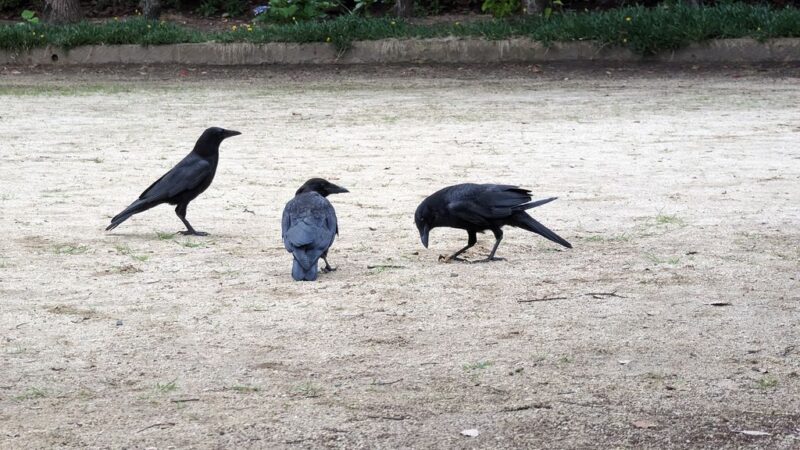
In this video, you can hear the very beautiful sound Junior makes when he/she wants to be fed:
I think this is the closest Dad ever came to me (he’s about two meters away). It was interesting to see him approaching. When the peanut is far, he just walks to it, but there, he approached laterally, probably to escape easily if I did anything sketchy.
I wish I could give him peanuts directly from hand to beak as I’ve seen some people do online, but I guess I’ll have to be very patient for that.
I love the details of the feathers in this picture (click it to enlarge it)


This last picture was taken on July 10th. It was the last time I spent time with the family:
They disappeared a few days later and were nowhere to be seen for two weeks.
I was torn between imagining the worst (especially because there was a morning with a lot of commotion and some very angry crows a few days before they left, but I was still inside and couldn’t see what was going on) and thinking that as Junior was ready to start its adult life, the whole family left to find him a place and other crows to hang out with (its older siblings, but not the ones in the park by the sea?)
Well, Mr. and Ms. Crow returned a few days ago, without Junior. I hope it’s fine and has started its new life. Will I see it again? No idea. I guess if one day a random crow, not too far from home, approaches me, it’ll be them.
Meanwhile, Mr. and Ms. Crow have been acting a little weird. They mostly remained on the other side of the park from my house. They came for peanuts, but are keeping their distance.
I assume that – as they were away for quite some time – they need to reassess the neighborhood. Are there new dangers? Are the things (and people) who were safe, still safe? etc. So it’ll probably take a little bit of time for them to feel comfortable around me again.
Still, yesterday, as I returned home, Mr. Crow must have noticed my car, because he was waiting for me on a cable. I had left some peanuts in my yard and he found them shortly after.
I left more with a bowl of water this morning. The peanuts were eaten, I hope he drank some water too, the poor things are so hot and thirsty at the moment.
Here is how they spent most of their morning today (and yesterday too) because it’s just too hot to do anything else and to go anywhere else (well, they were somewhere else this afternoon, not sure where):
Alright, that was quite a long post. Thanks a lot if you’re still reading.
I’ll tune you in with more news when I have some. Make sure to follow me on Mastodon or subscribe to this blog for more. (click the previous link for Mastodon, and click the logo below for your subscribing options):
Discover more from liminal web
Subscribe to get the latest posts sent to your email.


